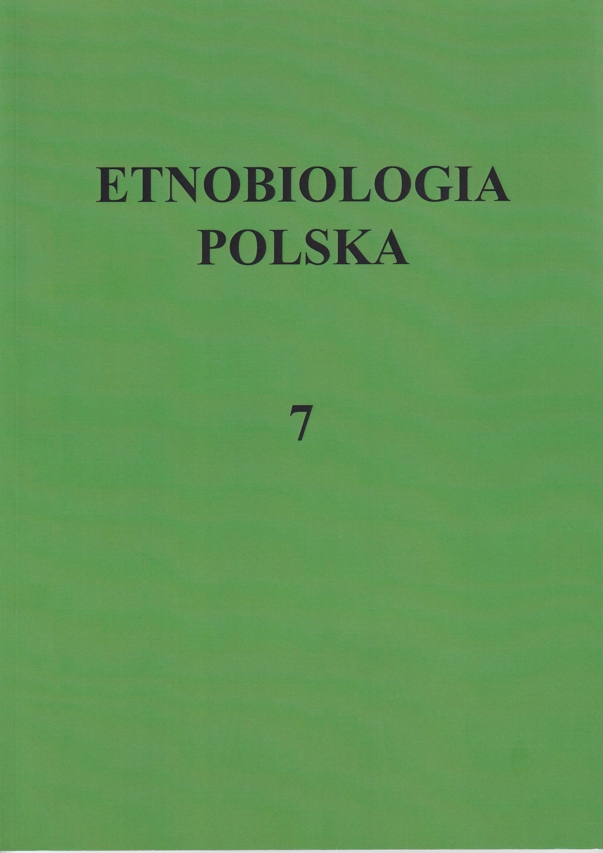Zatrucie piestrzenicą kasztanowatą – zapomniany problem: doniesienie kliniczne i przegląd literatury
Słowa kluczowe:
Gyromitra esculenta poisoning, mycophilia in PolandAbstrakt
False morel (Gyromitra esculenta) poisonings have been noted in Europe since the 18th century. In the Polish literature most cases, including fatalities, are to be found in the 1960s and 70s. The consequence of these publications was the recognition of G. esculenta as a poisonous species. As they rarely occur nowadays, these poisonings have not been particularly interesting for Polish toxicologists in recent decades. In April 2017 a 38-year-old man, an Orthodox priest, was hospitalised with gastrointestinal symptoms, jaundice and biochemical signs of liver damage. After 14 hours the patient had no ailments and left the hospital at his own request, due to his Easter duties. Three days later he returned to the hospital worried about persistent jaundice. He was treated for 7 days and was discharged in a good general condition and with significant improvement in biochemical assays. False morels had been received as a gift from his parishioners instead of true morels. Despite their known toxicity, false morels are still occasionally harvested and consumed, in the mycophilic Polish society. A few decades ago this mushroom was considered edible and it is still commercially available in some countries now. If not correctly prepared, it can cause serious poisoning. However, it seems that a more common cause of poisonings is the misidentification of false morel as true morel (Morchella esculenta). An exceptional case is poisoning with fungus accepted as a gift. This usually happens when both donor and beneficiary appreciate mushrooms, but neither one nor the other has sufficient experience in their recognition.
Downloads
Bibliografia
Bernard MA 1979. Mushroom poisoning in a dog. Canadian Veterinary Journal 20: 82-83
Boehm R, Külz E 1885. Ueber den giftigen Bestandtheil der essbaren Morchel (Helvella esculenta). Archiv für experimentelle Pathologie und Pharmakologie 19(6): 403–414
Burda PR 1998. Zatrucia ostre grzybami i roślinami wyższymi. Wydawnictwo Naukowe PWN. Warszawa
Coulet M, Guillot J 1982. Poisoning by Gyromitra : a possible mechanism. Medical Hypotheses 8(4): 325–334
Eisner M, Kurkowski M, Pilarska K, Koszarska J, Goertz J 1973. Zatrucie piestrzenicą kasztanowatą. Polski Tygodnik Lekarski 28(49): 1936-1939
Fiedorowicz-Fabrycy I, Lapis J 1968. Zatrucie piestrzenicą kasztanowatą. Wiadomości Lekarskie 21(6): 489-491
Finnish Food Safety Authority Evira 2010. False morel fungi – poisonous when raw. https://www.evira.fi/en/about-evira/publications/food/brochures/false-morel-fungi/ (28.09.2017)
Flammer R, Gallen S 1983. Hämolyse bei Pilzvergiftungen: Fakten und Hypothesen. Schweizerische Medizinische Wochenschrift 113(42): 1555-1561
Franke S, Freimuth U, List PH 1967. Über die Giftigkeit der Frühjahrslorchel Gyromitra (Helvella) esculenta Fr. Archiv für Toxikologie 22(5): 293-332
Giusti GV, Carnevale A 1974. A case of fatal poisoning by Gyromitra esculenta. Archives of Toxicology 33: 49-54
Graeme KA 2014. Mycetism: A review of the recent literature. Journal of Medical Toxicology 10: 173-189. DOI 10.1007/s13181-013-0355-2
Hanrahan JP, Gordon MA 1984. Mushroom poisoning. Case reports and a review of therapy. JAMA 251(8): 1057–1061
Karlson-Stiber C, Persson H 2003. Cytotoxic fungi - an overview. Toxicon 42(4): 339–349
Kreisel H 2005. Liste der ethnomykologisch und biotechnologisch relevanten Pilze. Feddes Repertorium 116(5–6): 339–391. DOI: 10.1002/fedr.200510078
Leathem AM, Dorran TJ 2007. Poisoning due to raw Gyromitra esculenta (false morels) west of the Rockies. CJEM 9(2): 127-130
Łuczaj Ł, Nieroda Z 2011. Collecting and learning to identify edible fungi in southeastern Poland: age and gender differences. Ecology of Food and Nutrition 50: 319-336
Michelot D, Toth B 1991. Poisoning by Gyromitra esculenta – a review. Journal of Applied Toxicology 11(4): 235-243
Nagel D, Wallcave L, Toth B, Kupper R 1977. Formation of methylhydrazine from acetaldehyde N-methyl-N-formylhydrazone, a component of Gyromitra esculenta. Cancer Research 37(9): 3458-3460
Orłoś H 1949. Grzyby jadalne i trujące. Nakładem Spółdzielni „Las”. IBL. Warszawa
Peintner U, Schwarz S, Mešić A, Moreau P-A, Moreno G & Saviuc P 2013. Mycophilic or mycophobic? Legislation and guidelines on wild mushroom commerce reveal different consumption behaviour in European countries. PLoS ONE 8(5): e63926. DOI 10.1371/journal.pone.0063926
Pilat A 1954. Über Vergiftungen mit der Speiselorchel, Gyromitra esculenta (Pers.) Fr. Sydowia 8: 349-354
Pyysalo H 1975. Some new toxic compounds in false morels, Gyromitra esculenta. Naturwissenschaften 62(8): 395
Pyysalo H, Niskanen A 1977. On the occurrence of N-methyl-N-formylhydrazones in fresh and processed false morel, Gyromitra esculenta. Journal of Agricultural and Food Chemistry 25(3): 644–647
Raszeja S 1959. Diagnostyka śmiertelnych zatruć piestrzenicą. Patologia Polska 10(1): 35-60
Rubel W, Arora D 2008. A study of cultural bias in field guide determinations of mushroom edibility using the iconic mushroom, Amanita muscaria, as an example. Economic Botany 62(3): 223-243
Saviuc P, Harry P 2008. Existe-t-il un syndrome neurologique d’ intoxication par les morilles? www.centres-antipoison.net/CCTV/Rapport_CCTV_Morilles_2008.pdf (20.09.2017)
Snowarski M 2005. Atlas grzybów. Wydawnictwo Pascal. Bielsko-Biała.
Stryamets N, Elbakidze M, Ceuterick M, Angelstam P, Axelsson R 2015. From economic survival to recreation: contemporary uses of wild food and medicine in rural Sweden, Ukraine and NW Russia. Journal of Ethnobiology and Ethnomedicine 11: 53. DOI 10.1186/s13002-015-0036-0 (12.09.2017)
Teodorowicz F 1938. Piestrzenica kasztanowata – Helvella esculenta Pers. Nowiny Lekarskie 20
Wasson VP, Wasson RG 1957. Mushrooms, Russia and history. 2 vols. Pantheon, New York
[Główny Inspektorat Sanitarny 2015. Stan sanitarny kraju.] https://gis.gov.pl/o-nas/glowny-inspektorat-sanitarny/stan-sanitarny-kraju (24.10.2017)
[O jadalności i toksyczności piestrzenicy kasztanowatej.] https://www.bio-forum.pl/messages/33/697.html (2.10.2017)
[Rozporządzenie Ministra Zdrowia z dnia 19 grudnia 2002 r. w sprawie grzybów dopuszczonych do obrotu lub produkcji przetworów grzybowych albo artykułów spożywczych zawierających grzyby oraz uprawnień klasyfikatora grzybów i grzyboznawcy. (Dz.U. 2003 nr 21 poz. 178)] http://isap.sejm.gov.pl/DetailsServlet?id=WDU20030210178+2008%2412%2424&min=1 (20.09.2017)
[Rozporządzenie Ministra Zdrowia z dnia 13 listopada 2008 r. w sprawie grzybów dopuszczonych do obrotu lub produkcji przetworów grzybowych oraz środków spożywczych zawierających grzyby oraz uprawnień klasyfikatora grzybów i grzyboznawcy. (Dz.U. 2008 nr 218 poz. 1399)] http://isap.sejm.gov.pl/DetailsServlet?id=WDU20082181399+2011%2406%2422&min=1 (20.09.2017)
[Rozporządzenie Ministra Zdrowia z dnia 17 maja 2011 r. w sprawie grzybów dopuszczonych do obrotu lub produkcji przetworów grzybowych, środków spożywczych zawierających grzyby oraz uprawnień klasyfikatora grzybów i grzyboznawcy. (Dz. U. z 2011 r. nr 115 poz. 672)] http://isap.sejm.gov.pl/DetailsServlet?id=WDU20111150672 (20.09.2017)
Pobrania
Opublikowane
Jak cytować
Numer
Dział
Licencja
Prawa autorskie (c) 2017 Etnobiologia Polska

Utwór dostępny jest na licencji Creative Commons Uznanie autorstwa – Użycie niekomercyjne – Bez utworów zależnych 4.0 Międzynarodowe.


